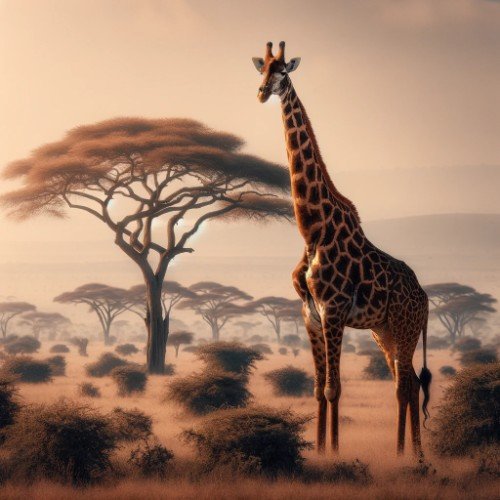The giraffe, with its towering height and long neck, roams the African savannah, while the camel, equipped to survive harsh desert conditions, traverses arid landscapes. Both are remarkable survivors in their environments, but how do they compare in aspects like endurance, fighting ability, and against predators? Let’s explore these intriguing creatures and imagine who might prevail in a hypothetical showdown.
Giraffe Size
The giraffe, the tallest mammal on Earth, stands as a majestic figure in the African savannah. An adult male can reach up to 18 feet in height, with its long neck accounting for much of this stature. This unique adaptation is vital for feeding on leaves and shoots high in the acacia trees, a dietary habit that minimizes competition with other herbivores.

Camel: The Desert Survivor
In stark contrast, the camel, specifically the Dromedary (one-humped) and Bactrian (two-humped) species, is a master of desert survival. Adapted to arid environments, camels are significantly shorter, with an average height of about 6-7 feet at the shoulder. Their humps store fat, which can be converted to water and energy, enabling them to thrive in harsh conditions where others would perish.

Endurance and Adaptability
In terms of endurance, camels are unrivaled. They can travel up to 100 desert miles without water, enduring extreme temperatures. Giraffes, while not built for such long treks, can go without water for weeks, thanks to the moisture in their leafy diet.
Combat and Defense Mechanisms
Giraffes are not typically aggressive but can be formidable when threatened. Their primary defense is a powerful kick that can shatter the skull of a predator. Their height and size also deter many would-be attackers. Camels, more docile, have less formidable natural weapons. They can bite and spit when irritated, but these are more annoyance tactics than true combat abilities.
Camel And Giraffe Bulls Fights
When it comes to understanding the combat behaviors of two male bulls, one from the giraffe species and the other from the camel species, it’s essential to delve into their distinctive fighting techniques, shaped by their environments and physical adaptations.

Giraffe Combat: The “Necking” Titans
Male giraffes, known as bulls, engage in a unique and somewhat elegant form of combat called “necking.” This involves two males standing side by side and swinging their long necks in an arc to deliver powerful blows with their heads. The force of these blows can be quite substantial, given the giraffe’s height and the muscular build of their necks. The objective is typically to establish dominance rather than to inflict serious injury, with the winner gaining mating rights.
Camel Combat: The Stoic Wrestlers
Camel bulls, on the other hand, have a very different approach. During mating season, they become quite aggressive. Their fights usually involve biting and head-butting. Camels have a tough mouth adapted to desert flora, which they use effectively in combat. They also use their necks to push and wrestle each other, aiming to pin their opponent to the ground. The humps of the camels can serve as a sort of shield, absorbing some of the impacts during these fights.

Comparing the Fighting Styles
The contrast in fighting styles is stark. Giraffe bulls engage in a more fluid, swinging combat, relying on the momentum and weight of their heads and necks. Camel bulls are more direct, using brute force, biting, and the strength of their bodies in a wrestling style.
The giraffe’s method is a test of endurance and strength, often lasting until one bull yields, while camel fights can be more intense and aggressive, with a clear aim to overpower and subdue the opponent.
In a hypothetical scenario where a giraffe bull and a camel bull were to confront each other, the dynamics would be unusual. The giraffe would likely try to use its height and neck strength, while the camel would aim to get close and engage in a more physical tussle. However, such an encounter is outside their natural behavior and habitat, making it purely speculative. In their respective environments, both these techniques serve them well in establishing dominance and competing for mates.
Natural Predators and Fighting Tactics
Giraffes must be wary of lions, the primary predator capable of taking down an adult. Their defensive strategy is to use their height and powerful legs to kick and keep predators at bay. Camels, on the other hand, have fewer natural predators, mainly due to their habitat. They are more likely to flee than fight.

The Hypothetical Confrontation
In a direct confrontation, several factors would come into play. The giraffe’s height and powerful kick are significant advantages. A well-placed kick could incapacitate the camel. However, the camel’s endurance and agility in sandy terrains could be beneficial, especially if it can outmaneuver the giraffe.
Verdict
If we were to simulate this unlikely battle, considering all factors – the giraffe’s powerful defense mechanisms, its size and strength, against the camel’s endurance and agility – the giraffe would likely have the upper hand. The probability of a giraffe winning this confrontation might be around 65%. This percentage considers the giraffe’s ability to deliver a potentially decisive and powerful kick, whereas the camel, despite its resilience and adaptability, lacks comparable offensive capabilities.
Remember, this analysis is purely hypothetical and speculative. In their respective ecosystems, both animals have evolved to thrive in very different ways, and a confrontation between them is beyond the realms of their natural behavior and environment.




